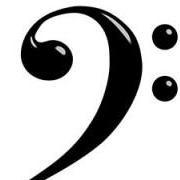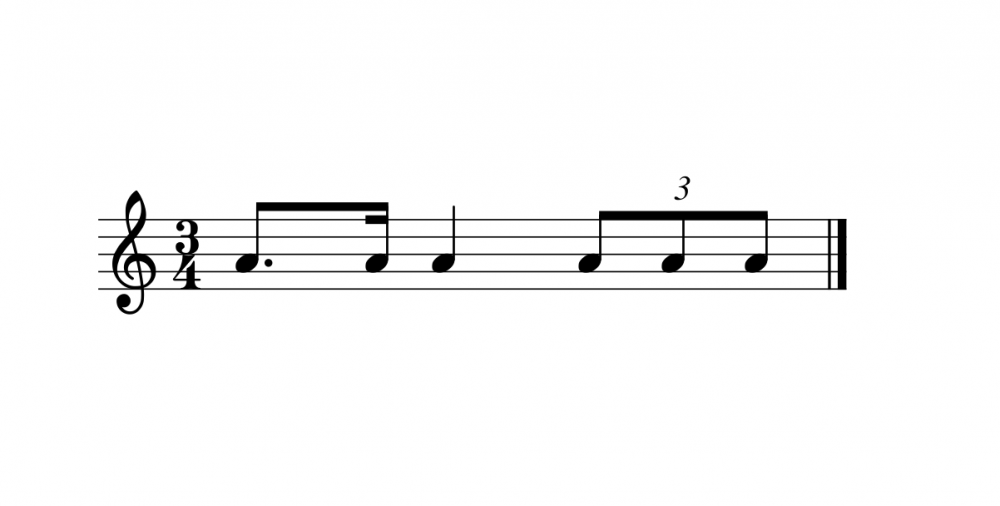Search the Community
Showing results for tags 'piano'.
-
Gradually trying to work up the keys. This nocturne is again an update like the Eb major one was. Its taking ages. Not sure about the time signatures or ending. No slurs as the software treats the slurs as a pedal sometimes. This piece might be a bit of a mess but don't know. Feedback is greatly appreciated. Thanks very much.
-
The text is the Spanish language version of the quote that starts Toni Morrison's "Beloved." Since she died this August, I was thinking about her books. Llamaré al que no era mi pueblo, pueblo mío; y a la no amada, amada. I will call the one who was not my people, my people; and the unloved, beloved.
- 6 replies
-
- biblical text
- spanish
-
(and 2 more)
Tagged with:
-
Edom means "red" in Hebrew, and it was and ancient city / region next to the Dead Sea.
-
First piece of my moments Musicaux set.
-
First Polonaise of mine.
-
Well, this is the recomposed version of a "minuet attempt" that I composed some time ago, I recomposed it just today. I recomposed it because the bass was very simple (just octaves in half notes), and it didnt have the form of a minuet. at least now it haves the form I include an harmonic analysis (very roughly) Almost all the minuet is based on the motive of the image The trio isn't finished, I will add it later Any comments are apreciated :3.
-
Sometimes inspiration comes from different places: a car passing by in front of you, leaves rustling in the wind, the username of a member of an online forum, or simply... it just is. My first sonata was inspired by one of these three things. Ironically, as long as I've been composing, this is my first... complete (well, somewhat, I'll probably renovate some of the movements later) piano sonata. I. Allegretto Grazioso: The entire sonata rests on the motif found in the bass. 5 simple notes. The motif in this movement is treated to development in a type of hybridized sonata form. II. Adagio Sostenuto: This is one of the movements that I'll probably strengthen later. The form is basic ABA'. I wanted the A section to have a solemn quality to it. Resignation. The middle section introduces some new material -but again is heavily resting on the 5 note motif found in the first movement. III. Presto - Andante con moto: The five note motif becomes the basis of the scalar material utilized in the first half of this movement. Despite being a tad basic, it provided some interesting sonorities -particularly with the infusion of chromaticism. The second half of this movement features snapshots of material utilized in the previous two movements (for the sake of maintaining cohesion throughout the piece). All in all, I'm fairly satisfied with this work. I'll most likely update the second movement -and the second half of the third. Hope you all enjoy!
-
I've decided to do something completely different than my normal thing. I've never enjoyed 12-tone serialism, but I decided to give it a little try. I don't follow the rules entirely, because I wanted to create something that uses it, but still sounds accessible and not like overly-academic wankery. The concept of the piece is a musical setting of the final stages of the Voyager I space probe leaving our solar system. It will be made up of 5 "Movements" with little or no separation between. The flute is the probe while the piano is the sun and it's solar wind, particles, etc. early in the piece and other stars in the final movement. Since the probe is a non-living thing, I decided to go with a more robotic sound created using a 12 tone row (divided into four triads) and some of its' inversions. Again, to make it more listener-friendly, and frankly because I wanted to, I didn't stick to any real rules or conventions here. In the first movement "Termination Shock", Voyager I goes through the point in the heliosphere where the solar wind slows down to subsonic speed (as demonstrated by the slowing tempo) while the temperature rises a bit (warmer sounds from the "sun"). The movement starts with just the "sun" before "Voyager I" powers back up to send its' message home. I will post the other movements as I finish them...
-
This is one of my longer works; just finished it today, so yay! I could really used some feedback for future versions, though. The formatting is also a little suspect, as are the harmonies, perhaps. I was going for an Impressionistic style. It is inspired by the journey of the Christian faith.
-
This piece doesn't really expand on the idea of the episode much more than the last one -instead, I develop more attention to the material within the overall structure. Sorry for the rendering, I think the sffz destroyed my speakers!!!
- 5 replies
-
- piano
- contrapuntal
-
(and 1 more)
Tagged with:
-
I always wanted to write something for violin because is one of my favorite instruments allong with guitar and piano, so I decided to write a preludio and allegro (that was some time ago). But when I showed it to one friend of mine who is a violinist, she said that more than a prelude it feels like and etude because of the very high notes in measures 12,13,28,29,56 and 57. So, i would like a second, third etc opinion about that. For all the violinist out there, are those notes that hard to play, and how is the prelude overall?. Thanks in advance for all the comments :3.
-
Hello ! I'm sharing one of my compositon with you 🙂 I compose it last year when I had my exams. It was a very stressfull moment for me so I decide to compose 😛 Sheet music : apaisement_2 - Copie.pdf Hope you enjoy it 🙂 version_finale_apaisment 2.mp3 Julien Kaw
-
Well, this is a rondo that I composed some time ago. I know the last measures are almost impossible to play, i will nerf them later. Any comment is apreciated :3..
-
Hello Guys ! First of all, HAPPY NEW YEAR !!! I'd like to share with you another of my composition which is " In Limbo " Hope you enjoy it 🙂 Julien Kaw limbes.mp3
-
Hi :3, I´m new to this forum. I'm a begginer composer I would like to have some feedback on my first piano sonata. Thanks in advance for the comments. I added an mp3 an here is a link to a youtube video with the sheet music. https://www.youtube.com/watch?v=ODoW8caLo0k Here is an analysis of the structure. 0:00 exposition 0:00 Introduction 0:26 first theme C minor 0:45 bridge 0:51 transition theme Eb minor 1:03 bridge 1:14 Second theme Eb major 1:29 Transition 1:37 retransition progression by circle of 5th 1:44 second theme Eb major 1:52 retransition to the first theme 1:59 repetition of the exposition 3:25 Development 4:13 dominant preparation 4:42 recapitulation 4:42 first theme C minor 5:02 bridge 5:09 transition theme C minor 5:32 second theme C minor 5:47 bridge F minor 6.02 second theme C minor 6:10 Coda C----------> Eb major-----> C minor
-
-
In this piece, I've taken the ideas I had behind the formal structure of my earlier upload, Episode #1, and I've changed it up a bit (largely listening to the critiques that work garnered). I've never been good describing my ideas in detail -long standing trait. Much like Episode #1, this work takes the basic Rondo structure and expands upon it. When I originally thought of the idea for an episodic (rondo-like) formal structure, my original goal was to intersperse the A sections with heavily contrapuntal material (B, C, and D sections all being fugal in nature). While I still may do a work like this in the future, I think that -for now- I'm trying to find a way to make this type of structure work for the language that I use in my works. The score is a lot nicer (thank you MUSESCORE!)
-
Hey everyone ! I'd like to share with you my first composition which is " L'étoile " ( the star in french) I hope you enjoy it 🙂 See ya J.Kaw © Julien_Kaw version_finale_etoile.mp3
- 4 replies
-
- 1
-

-
- orchestra
- orchestral
-
(and 2 more)
Tagged with:
-
After a two-year hiatus, for the month of December I decided to go back working on this set of 26 minuets which I have been working on off from 2016 to 2017, and stopped in 2018 when I have other things to work on. Here's the status of the minuets as of April 2018: Anyway, after that and up till December, I have gained new musical knowledge and experiences which can be reflected in this new version of the set. More dynamics are added, the pitch range has also been expanded as well and incorporating other forms (Rondo and Sonata) into a few of the minuets as well. Many of the musical ideas for the minuets are taken from several sight-reading books, string quartets by Mozart and Haydn and other composition and theory workbooks. It has been quite a lot of fun finishing the set, exploring new musical ideas and many major/minor keys, and through this I have grown as a composer. I plan to move beyond the piano and work on a set of preludes and fugues for string quartet after this. I also hope to live record these minuets one day, especially the whole tone (XXV). Any suggestions on how to improve, or if you need to understand some of my thinking behind the minuets, you can say so in the comments. (I'm still working on a commentary by the way, but need to tell you that the last uses two different octatonic scales for the minuet and trio respectively.) For those who are not able to listen to the whole set, I suggest looking into these: II (A minor), IV (E minor), VI (E minor), VII (A major), IX (E major), XII (G sharp minor), XIII (F sharp/ G flat major), XIV (E flat minor), XVI (B flat minor), XIX (E flat major), XX (C minor), XXIII (F major), XXIV (D minor), XXV (Homage to Debussy), XXVI (Homage to Prokofiev).
-
While working on this piano concerto, I have a lot of material that I'm leaving out -and have decided to use in smaller works (particularly for the purpose of keeping clarity in my material for the concerto). This work uses a tone row built upon intervals of the 4th. The opening bar, which creates a ritornello throughout the work, is the full row. Some notes about the compositional processes I used in this piece: 1. The form could be considered a rondo of sorts. The ritornello passage is labeled E. This returns after each 'episode' labelled C. I chose to keep this material identical. I may at a later date change the last entrance of the ritornello (mirroring it into the retrograde so that it ends on the note the piece begins). 2. The various episodes tinker with aspects of counterpoint (stretto, imitation, invertible counterpoint). The first episode superimposes rhythmic variants of the thematic material creating a rich texture. The second episode takes this type of superimposition and thins it out a little bit (leaving the superimposition to only two voices, while the remainder of the material is condensed into the chords seen in the left hand). NOTE: The second episode does NOT use the full tone row at all -at least not in order. The third episode plays around with invertible counterpoint and imitation, with a twist. The final episode -nearly devoid of counterpoint- is more intended on providing material to close out the piece. Hope you enjoy. I'll be cleaning up the score here in a few weeks once I get my new laptop set up!
-
I wanted to share this little piece composed by a friend of mine and me, two years ago, for Christmas. It was inspired by the facts taking place in World War I, when there was a spontaneous truce in Belgium. Each band (English and German) started to sing Silent Night in their own languages, the fighting was stopped, and they even shared gifts and hugs. The next day they buried the fallen soldiers... (Sorry, in the score it is explained in Spanish).
-
The beauty of music is that it brings people together. From all over the world! It’s an universal language to which we all can connect. A couple of months ago I met macky@piano♪♪(まっきぃ) She is a wonderful pianist from Japan playing outstanding improvisations. Music that speaks to the heart and mind. I'm a big fan of her and it is a great honour to do this collaboration with her. A sweet, romantic music track within the atmosphere of Christmas. On the piano: macky@piano♪♪(まっきぃ) Arrangement, mixing and mastering: David Jansen [a.k.a. Gh0stwrit3r] I hope you enjoy it!
- 4 replies
-
- piano
- orchestral
-
(and 2 more)
Tagged with:
-
the expositions of my piano concerto in G minor as well as the beginning of the development. any feedback welcome.
-
"Christmas time's a-comin'"... Around this time of the year I use to make something with popular carols (reharmonization, fugues,.... just for fun). However, I'd like to write my own two or three "carols = villancicos", differences aside, .... because this is not for singing. It's just how I think about and feel this time. So, I let my "harmonic imagination" fly and this is it.
- 4 replies
-
- villancico
- carol
-
(and 3 more)
Tagged with:





